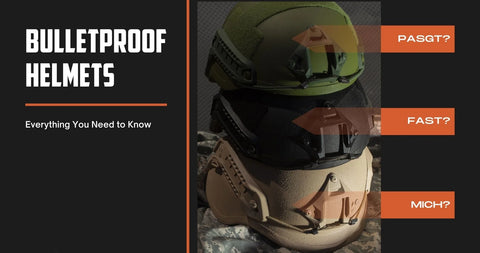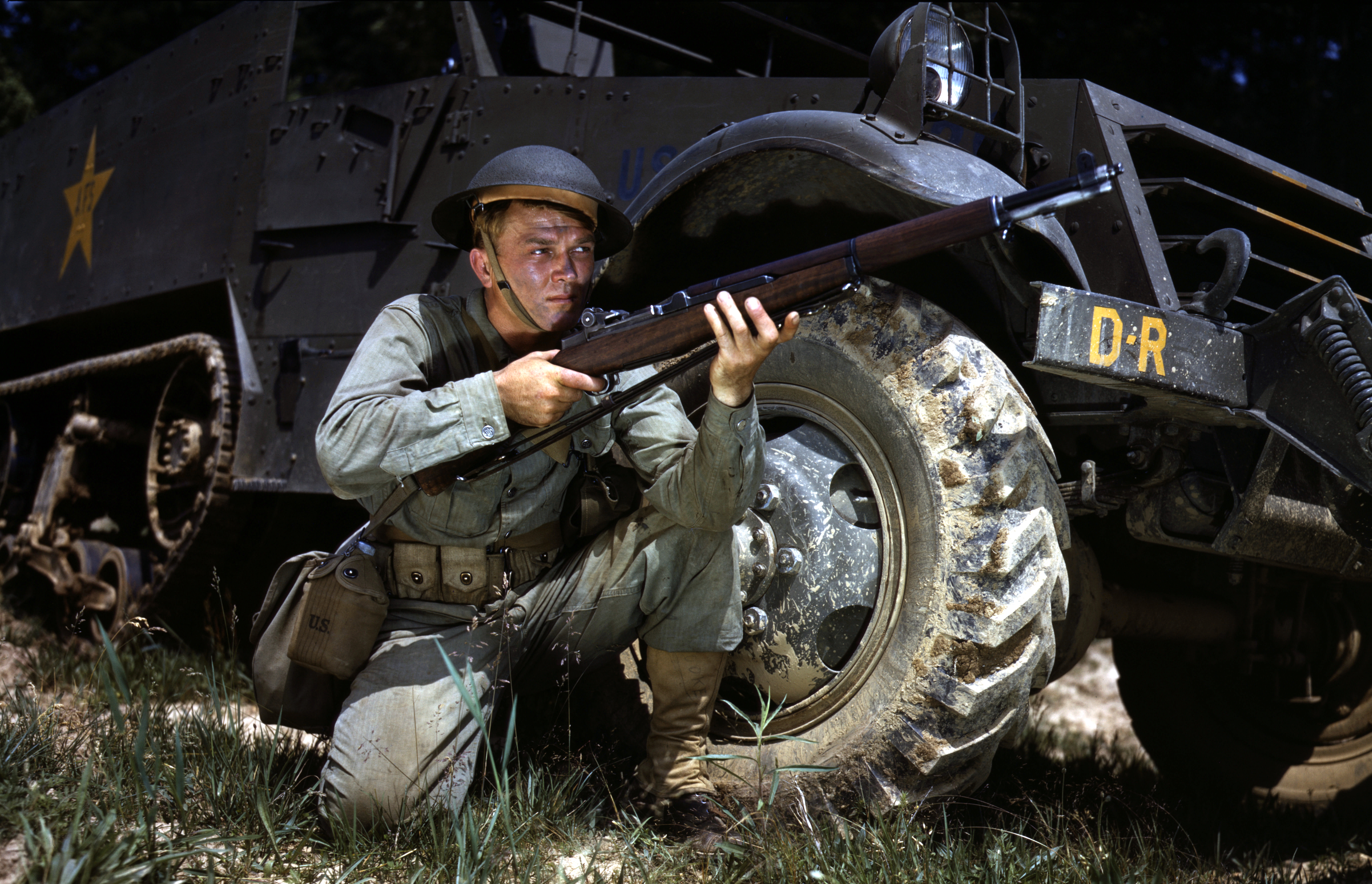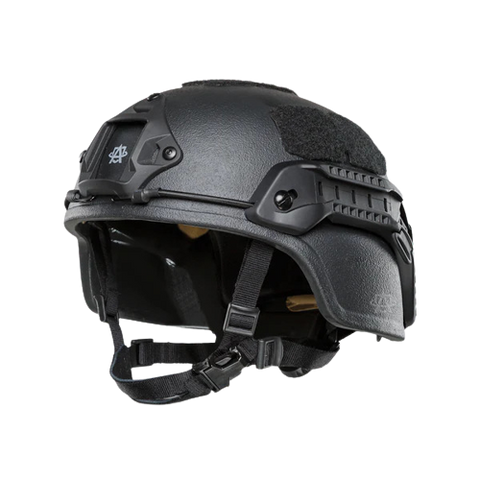Looking to round out your tactical loadout with some ballistic headgear? With so many brands on the market competing to provide you with the best ballistic helmet, picking the right one can be a daunting task.
Keeping your head is top priority, so we'll help take out the guess-work. In this guide, we'll walk you through the different types of ballistic helmets, their pros and cons, and our top picks.

Read on for everything you'll ever need to know about bulletproof helmets!
Table of Contents
- What is a Bulletproof Helmet?
- A (Brief) History of the Modern Bulletproof Helmet
- Types of Bulletproof Helmets and their Usage
- Non-Ballistic Helmets
- What's in a Ballistic Helmet?
- Are Ballistic Helmets worth it?
- Are Ballistic Helmets legal?
- Are there Bulletproof Motorcycle Helmets?
- What are the best Bulletproof Helmets?
- When do I need a Bulletproof Helmet?
WHAT IS A BULLETPROOF HELMET?
A bulletproof helmet, or more accurately 'ballistic helmet', is a tactical helmet designed to protect the wearer's head from threats such as ballistic impact (bullets), blunt impact, and blast debris.
It is typically worn in conjunction with ballistic-resistant body armor to provide full coverage and protection.
Traditionally, members of the military wear the ballistic helmet for combat, and it is also a common piece of gear for law enforcement in tactical situations, but even civilians just looking for extra ballistic protection when working with firearms can make good use of them.
It has to be mentioned that no protective material currently on the market can technically be guaranteed "bulletproof."
Readily available tactical equipment might be certified bullet resistant against a certain range of weapons, but that's more than adequate for most use cases.
Bear this in mind before you move on to purchase a new ballistic helmet. They won't stop every bullet coming at you, but that doesn't mean they won't still save your life.
Let's look at how bulletproof helmets have evolved over the years.
A (BRIEF) HISTORY OF THE MODERN BULLETPROOF HELMET

In the early days of warfare, soldiers protected their heads with cloth or leather to protect themselves.
For most of the 20th century, combat helmets were essentially bowl-shaped steel shells that fit into a hard-hat type liner.
The bulletproof helmet as we know it today first saw widespread adoption with World War I.
Known as the M1917 helmet, the U.S. variation on the British Brodie helmet, did little more than keep soldiers' heads safe from explosion-propelled rocks in the trenches.

The U.S. government first utilized Kevlar in the manufacturing process for the M1 helmet liner making it one of the first Kevlar helmets. Used by the U.S. military from World War II to 1985, the M1 offered a moderate increase in protection from flying pieces of steel shrapnel, but it still wasn't bulletproof.
They've come a long way since then.
FROM STEEL BOWLS TO SLEEK HEADGEAR RESISTANT TO MODERN WEAPONS OF WAR
In 1960, a new material called Aramid was developed courtesy of DuPont. Aramid is a durable fiber resistant to heat. This novel material was marketed as “Kevlar,” and -being a whopping five times stronger than steel - it revolutionized the design and production of ballistic body armor.
In the 1970s, there came along another strong synthetic fiber of the Aramid family - Twaron.
The fact is that both Kevlar and Twaron are five times stronger than steel and yet flexible, able to be incorporated into a variety of products that need strength and extreme durability, such as ballistic protective gear.
The main difference between the two materials lies in their manufacturers and their timeline of usage:
Dupont gave us Kevlar, which came into commercial use in the 70s.
Teijin gave us Twaron, which was first used commercially in 1986.
These materials changed the game.
Clearly, ballistic helmets have been evolving to meet the needs of today's military and law enforcement officers. They've undergone major developments in terms of shape, weight, and materials, becoming stronger, lighter, and sleeker in cut to provide good visibility without sacrificing performance.
The M1 helmet was eventually replaced by the Personnel Armor System for Ground Troops (PASGT).
The PASGT was in turn replaced by the Modular Integrated Communications Helmet (MICH) designed and developed by the US Special Operations Command.
In 2002, the U.S. Army adopted MICH and renamed it to Advanced Combat Helmet (ACH).
Compare all this to the future of military headgear, the Enhanced Combat Helmet, which can protect from up to NIJ level IV. You'll often see these acronyms used when referring to different kinds of helmets and how they're used.
Today's ballistic helmets serve a dual purpose, not only protecting the head area from bullets, blunt impacts, and debris fragments, but also acting as mounts for extra gear.
With advancements in combat technology, many modern helmets, especially those used by the military, must be able to support communications equipment and various gear and accessories such as an NVG shroud (night vision goggles).
TYPES OF BULLETPROOF HELMETS AND THEIR USAGE
Here’s a quick table with the types of bulletproof helmets and their usage.
You can learn more about why there are so many different kinds of Bulletproof Helmets in our article on the topic. Below we'll explain each type of helmet.
TACTICAL HELMET TYPES
Today, there are three main types of helmets on the market: the Future Assault Shell Technology helmet (known as the FAST helmet), the Modular Integrated Communications (MICH) helmet, and the Personnel Armor System for Ground Troops (PASGT) helmet.
Each helmet has a different history, design, and purpose.
PASGT ("K-POT," "KEVLAR HELMET")
The oldest and perhaps most influential design of the three ballistic helmets available for general purchase today, the PASGT (pronounced PAZ-get) was used by the U.S. military from 1983 to the mid 2000s as one component of a protective gear set that also included a ballistic vest.
This ballistic helmet is a tried and true model and is still in use today by the U.S. Army Reserve and the U.S. Navy for sailors on warships.
It's the original gold standard when it comes to ballistic protection.
Key features of this helmet include an outer shell usually of multi-layer Kevlar, a low cut over the ears, and a lip over the brow. It is available in a range of colors and patterns for use in different branches of the armed forces and weighs 3.1 lbs. to 4.2 lbs. (1420 g. to 1910 g.).
With precise drilling into the Kevlar, the helmet can be outfitted with add-on accessories such as a mount assembly for night vision goggles and a riot control visor.

MICH ("ACH")
The MICH is the next generation of the PASGT.
It was released in early 2001, after experiments aiming to design a ballistic helmet which was lighter and more comfortable yet still as protective as its predecessor.
When the U.S. Army adopted the MICH in 2002, the helmet was renamed the Advanced Combat Helmet (ACH).
The helmet weighs 3.0 lbs. to 3.6 lbs. (1360 g. to 1630 g.) and is made of an advanced Kevlar material. It comes in a range of camouflage patterns or solid black for use by SWAT teams.
Two other main goals in the MICH's creation was that the helmet could easily be mounted with accessories and wouldn't shift forward over the eyes in certain positions when pushed by the high collar of the Interceptor (the vest component of the military body armor system).
To accomplish these aims, the brow was eliminated and the sides were raised, resulting in 8% less coverage but improved visibility, comfort, and situational awareness - a worthwhile trade-off.
Rails were also added along the sides for mounting accessories without the need to drill into the Kevlar.
The MICH is currently one of the helmets used by a number of armed forces, including the U.S. Marine Corps Forces Special Operations Command and the U.S. Air Force Security forces.
FAST ("HIGH CUT/" "ABOVE THE EAR/" "ATE"/ "MARITIME CUT"/"COMBAT HELMET")
The manufacturing company Ops-Core unveiled the FAST ballistic helmet at the 2009 SHOT Show, and it was soon issued to U.S. special operations forces in Afghanistan.
Today, a number of special ops forces use different variants of the FAST.
One immediately noticeable trait of the FAST setting it apart from any other ballistic helmet is that it features high cut sides, leaving the ears exposed. The helmet then curves back down to protect the occipital bone at the back of the head.
The original purpose of this high cut ear design was for use in maritime special operations.
More traditional helmet models proved hazardous to wear at sea when travelling at high speeds because water could catch in the ear cups.
The helmet's high cut and the side rail system allow for the mounting of additional combat accessories including earphones, electronic ear muffs, and a night vision goggle shroud.
Obviously, a MICH helmet supports these accessories, too, but another distinguishing feature of the FAST is its weight.
It is significantly lighter than the MICH at only 2.2 lbs. to 3.0 lbs. (1143 g. to 1354 g.) as it's made of a composite of Carbon, Uni-directional Polyethylene, and Woven Aramid.

NON-BALLISTIC HELMETS
WHAT IS A BUMP HELMET?
Some tactical helmets are ballistic resistant while others are not.

Bump helmets, as non-ballistic helmets are called, are not rated for gunfire of any kind, but they are designed to protect against other impacts one might encounter in a combat situation, like shrapnel or falling debris.
A bump helmet can also be a good piece of protective gear during natural disasters such as tornadoes and hurricanes.
They are significantly lower in price than ballistic helmets and very lightweight, making them good for tactical training scenarios as well.
IS A BUMP HELMET WORTH IT?
Definitely, as long as there isn't a threat of bullets during your tactical work. (Otherwise, you'd need a ballistic helmet.)
In fact, a number of Special Operations Forces make use of bump helmets for mounting equipment such as night vision goggles.
WHAT IS A BUMP HELMET MADE OF?
A bump helmet is usually constructed out of polymer plastic or carbon fiber. This makes the helmet very lightweight, at roughly 1.4 lbs. (635 g.)
WHAT'S IN A BALLISTIC HELMET?
Most of the companies today are incorporating their patented padding and suspension systems to come up with the best ballistic helmets.
Today's ballistic helmets are composed of an outer shell of bullet-resistant material such as Kevlar, a retention system including a chin strap, and a suspension system consisting of shock-absorbing pads.
Some of the latest features that can be found in bulletproof helmets include:
- Velcro attachments for the modularity of end users.
- Proper padding to perfectly fit the human head.
- Moisture-absorbing material to reduce bacterial growth.
- Enhanced comfort and safety.
- Retention system – 4-point-chin strap and dial adjustment at the back of the helmet.
ARE BALLISTIC HELMETS WORTH IT?
The research on ballistic protection speaks for itself: For those facing military combat, casualties from ballistic impact can be decreased 19% with helmet use and cut in half by wearing body armor with a helmet.
Research from the National Library of Medicine shows that "although the head involves only 9% of the body area exposed during combat but still receives over 20% of all the 'hits'."
So the answer is an absolute YES!
Bulletproof helmets are meant to protect the wearer against different combat-based threats such as fragments, gunshots, shrapnel, explosions, etc.
However, a gunshot is not always from normal range during combat. For example, a ballistic helmet is unlikely to protect you from a sniper shot.
However, in the case of short-distance bomb explosions, a bulletproof helmet saves the day by protecting your skull from getting crushed into pieces and your brain from getting damaged.
Moreover, if you’re in a vehicle that comes face to face with an IED, the ballistic helmet keeps your head in place while it gets banged against the vehicle during a collision or accident.
Currently, the ACH is the most effective against fragmentation and small arms fire.
IS A BALLISTIC HELMET WORTH IT IF YOU'RE NOT MILITARY?
It depends on the situation. Law enforcement, security guards, correctional officers and people in related similar professions are more likely to be threatened with impact weapons and thrown projectiles than bullets.
Is a ballistic helmet useful to someone facing blunt impact threats?
YES, thanks to the blunt impact protection that these helmets also provide.
A chair hitting the head in just the wrong spot can be just as deadly as a bullet, and the blunt impact performance of a ballistic helmet can be a literal lifesaver in these cases.
ARE BALLISTIC HELMETS LEGAL?
Body armor is generally legal on the Federal level in the United States, but there are state-by-state restrictions and some restrictions mostly true across the board.
In most states it is illegal to wear body armor if you have been convicted of a felony. It is also generally a crime to use body armor during the commission of a felony and can bring the associated extra penalties.
It's important to always know your rights, so check out our comprehensive explanation of body armor legality on a state basis.
ARE THERE BULLETPROOF MOTORCYCLE HELMETS?
At this time, no.
While one would think that a your bulletproof helmet could double as a motorcycle helmet, this is not the case.
A motorcycle helmet is designed to crumple in order to absorb the impact of a crash or collision.
On the other hand, a ballistic helmet is designed to stop a bullet or projectile from penetrating into your skull.
Do not use your ballistic helmet as a motorcycle helmet. It won't provide adequate protection in a collision.
And it bears mentioning that motorcycle helmets are not designed to stop bullets. Don't rely on one in a firefight.
WHAT ARE THE BEST BULLETPROOF HELMETS?
If you’re looking for the best bulletproof helmets on the market, you can check out our selection for some of the most compelling ballistic helmets.
The best helmet for you depends on your needs, comfort, and budget. Also make sure to get the right size for you for optimum comfort and protection.
Based on extensive market research and reviews from satisfied customers, here are two of the best-rated bullet proof helmets for you:
LEGACY MICH LEVEL IIIA BALLISTIC HELMET

Notable features:
- Level IIIA Protection NIJ 0101.06
- Front Wilcox NVG mounting shroud
- Standard MICH/ACH Pads and Suspension Fixed side rails for mounting accessories
- Ergonomic and stable platform
Check out the Legacy MICH level IIIA Ballistic Helmet
PROTECTION GROUP DENMARK LEVEL IIIA ARCH BALLISTIC HI-CUT HELMET

Notable features:
- Top tier ballistic helmet
- NIJ Level IIIA Protection - V50 ballistic test
- Accessories can be attached to the rail system
- EN397 certified, which gives an excellent shock absorption against bullet impact in head and neck
Check out the Protection Group Denmark ARCH Level IIIA Bulletproof Helmet
When choosing the right helmet, be sure you know how to find the right size.
WHEN DO I NEED A BULLETPROOF HELMET?
People looking to add tactical headgear to their loadout should consider the situations they expect to be in.
If you expect to be in a combat situation then a ballistic helmet is a no brainer.
But if you only expect to be in a dangerous environment without enemy combatants, then a bump helmet may suffice.
Remember, there’s a certain degree to which each type of helmet can protect the wearer against shrapnel, bomb explosions, AK47 gunshots, and more. Much of that depends on its protection level, so make sure you choose the best level for your situation.
Top manufacturers are always improving ballistic technology. If you're looking to pick up a bulletproof vest, here are some considerations for you.
Check back here for new updates and developments for ballistic helmets.
Have any questions or points that you would like to add? Let us know in the comments section below.
